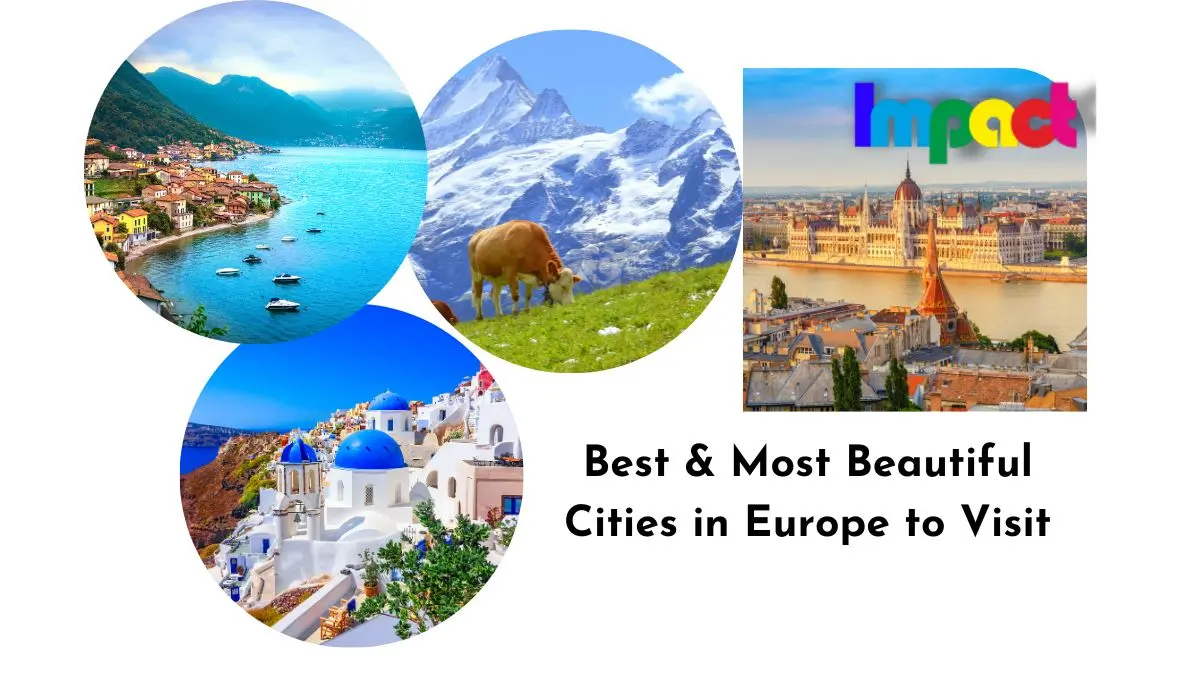
Europe is a continent of diverse cultures, languages, landscapes, and histories. It is also home to some of the most beautiful cities in the world, where you can admire stunning architecture, enjoy rich cuisine, explore fascinating museums, and experience vibrant nightlife. But with so many options to choose from, how do you decide which cities to visit in Europe? To help you plan your next trip, we have compiled a list of 10 of the best and most beautiful cities in Europe that you should not miss. Whether you are looking for romance, culture, adventure, or relaxation, there is a city for you on this list.
Table of Contents
Top 10 Most Beautiful Cities in Europe:
#1 Venice, Italy
Venice is one of the most unique and enchanting cities in Europe. Built on a lagoon of 118 islands connected by bridges and canals, Venice is a masterpiece of art and engineering. You can explore the city by taking a gondola ride along the Grand Canal, admiring the Byzantine domes of St. Mark’s Basilica, visiting the Doge’s Palace and its Bridge of Sighs, or wandering through the narrow alleys and hidden squares of the historic center.
Venice is also famous for its carnival, which takes place every year in February or March. During this time, the city is filled with colorful masks, costumes, and festivities. Venice is a romantic and magical destination that will leave you breathless.
#2 Prague, Czech Republic
Prague is one of the most photogenic and charming cities in Europe. The capital of the Czech Republic has a rich and turbulent history that is reflected in its architecture, from Gothic cathedrals and Baroque palaces to Art Nouveau buildings and Cubist houses. Prague is also known for its cultural scene, with numerous theaters, opera houses, galleries, and museums.
One of the highlights of Prague is the Old Town Square, where you can see the astronomical clock, the Tyn Church, and the statue of Jan Hus. Another must-see is the Prague Castle, which dominates the city skyline and offers panoramic views from its hilltop location. Prague is a city that will captivate you with its beauty and atmosphere.
#3 Lisbon, Portugal
Lisbon is a vibrant and colorful city that combines tradition and modernity. The capital of Portugal is located on the banks of the Tagus River and has a mild climate all year round. Lisbon is famous for its tiled façades, hilly streets, historic trams, and fado music.
You can discover Lisbon by visiting its iconic landmarks, such as the Belém Tower, the Jerónimos Monastery, the São Jorge Castle, and the Monument to the Discoveries. You can also enjoy the views from one of the many miradouros (viewpoints) or relax at one of the beaches nearby. Lisbon is a city that will charm you with its culture and hospitality.
#4 Bergen, Norway
Bergen is a picturesque city surrounded by mountains and fjords. The second largest city in Norway is known for its colorful wooden houses along the historic wharf of Bryggen, a UNESCO World Heritage Site. Bergen is also a cultural hub, with many museums, art galleries, festivals, and markets.
You can explore Bergen by taking a funicular up to Mount Fløyen, one of the seven mountains that encircle the city. From there, you can enjoy stunning views of the city and the sea or hike through the pine forests and lakes. You can also take a boat trip to see some of the most spectacular fjords in Norway. Bergen is a city that will awe you with its natural beauty.
#5 Florence, Italy
Florence is the cradle of the Renaissance and one of the most artistic cities in Europe. The capital of Tuscany is filled with masterpieces of art and architecture, such as the Duomo, the Uffizi Gallery, the Ponte Vecchio, and the Palazzo Vecchio. Florence is also a gastronomic paradise, where you can taste delicious Tuscan cuisine and wine.
You can experience Florence by walking through its elegant squares and streets or by renting a bike or a Vespa. You can also visit some of the nearby attractions, such as Pisa , Siena , or San Gimignano . Florence is a city that will inspire you with its culture and elegance.
#6 Paris, France:
No list of beautiful cities in Europe would be complete without Paris, France. This city is one of the most popular and romantic destinations in the world. Paris has everything you could wish for: iconic landmarks such as the Eiffel Tower, the Arc de Triomphe or the Notre Dame Cathedral; world-class museums such as the Louvre, the Orsay or the Pompidou; elegant boulevards such as the Champs-Élysées or the Saint-Germain-des-Prés; charming neighborhoods such as Montmartre or Le Marais; and of course, delicious food, wine and pastries.
#7 Rome, Italy:
Rome is a city that needs no introduction. The eternal city is a treasure trove of history, art, culture, and cuisine. From the ancient ruins of the Colosseum, the Pantheon, and the Roman Forum, to the majestic splendor of the Vatican, St. Peter’s Basilica, and the Sistine Chapel, Rome will awe you with its monuments and masterpieces.
Rome is also a city that celebrates life. You can enjoy the dolce vita by sipping espresso at a café, strolling along the cobblestone streets, tossing a coin into the Trevi Fountain, or indulging in a gelato or a pizza. Rome is a city that will make you fall in love with its beauty and charm.
#8 Amsterdam, Netherlands:
Amsterdam is a city that combines elegance and edginess. The capital of the Netherlands is famous for its canals, bridges, bicycles, and flowers, as well as its liberal and tolerant attitude. You can explore the city by taking a canal cruise, visiting the Anne Frank House, admiring the works of Van Gogh and Rembrandt at the museums, or browsing the quirky shops and markets.
Amsterdam is also a city that knows how to have fun. You can experience the nightlife at the bars, clubs, or coffee shops, or join one of the many festivals and events that take place throughout the year. Amsterdam is a city that will surprise you with its diversity and creativity.
#9 Budapest, Hungary:
Budapest is a city that blends old and new. The capital of Hungary is divided by the Danube River into two parts: Buda and Pest. Buda is the hilly and historic side, where you can find the Castle District, the Fisherman’s Bastion, and the Matthias Church. Pest is the flat and modern side, where you can find the Parliament Building, the Heroes’ Square, and the Jewish Quarter.
Budapest is also a city that offers relaxation and rejuvenation. You can soak in one of the many thermal baths, such as the Szechenyi or the Gellert, or enjoy a massage or a spa treatment. You can also savor the Hungarian cuisine and wine at one of the many restaurants or cafes. Budapest is a city that will delight you with its beauty and hospitality.
#10 Barcelona, Spain:
Barcelona is a city that radiates energy and style. The capital of Catalonia is known for its architecture, art, culture, and cuisine. You can marvel at the whimsical creations of Gaudi, such as the Sagrada Familia, Park Guell, and Casa Batllo. You can also admire the works of Picasso and Miro at the museums or explore the Gothic Quarter and La Rambla.
Barcelona is also a city that embraces life. You can enjoy the sun and sea at one of the beaches or parks. You can also taste the tapas and sangria at one of the bars or restaurants or dance the night away at one of the clubs. Barcelona is a city that will enchant you with its flair and vibrancy.
The Factors that Make These Cities So Beautiful:
There are many factors that contribute to the beauty of these cities. Some of the most important factors include:
- History: Many of these cities have a long and rich history, which is reflected in their architecture and culture.
- Art and culture: These cities are home to some of the world’s most famous works of art and architecture.
- Natural beauty: Many of these cities are located in stunning natural settings, such as Venice, which is built on a lagoon.
- Charm: These cities have a certain charm that is hard to define, but it is what makes them so special.
What to See and Do in These Cities:
There are endless things to see and do in these beautiful cities. Here are just a few ideas:
- Visit the historical landmarks: These cities are home to some of the world’s most famous historical landmarks, such as the Eiffel Tower in Paris and the Colosseum in Rome.
- Explore the museums and art galleries: These cities are home to some of the world’s most famous museums and art galleries, such as the Louvre in Paris and the Uffizi Gallery in Florence.
- Enjoy the local cuisine: These cities have some of the best food in the world, so be sure to try some of the local dishes.
- Take a walk through the parks and gardens: These cities have some beautiful parks and gardens, such as the Jardin du Luxembourg in Paris and the Boboli Gardens in Florence.
- Just wander around and soak up the atmosphere: These cities have a certain magic that is hard to describe, so just wander around and enjoy the atmosphere.
How to Plan a Trip to Europe on a Budget:
Europe is a dream destination for many travelers, but it can also be an expensive one. With so many countries, cultures, and attractions to explore, it can be hard to stick to a budget and make the most of your trip. However, with some smart planning, research, and flexibility, you can travel to Europe on a budget and have an unforgettable experience.
Here are some tips on how to plan a trip to Europe on a budget:
1. Choose your destination wisely:
Europe is a diverse continent, and the cost of traveling can vary significantly depending on where you go. Some of the most popular destinations, such as France, Italy, Spain, or the United Kingdom, tend to be more expensive than others, especially in the peak season. On the other hand, some of the less visited or emerging destinations, such as Portugal, Greece, Poland, or Romania, can offer more value for money and less crowds.
To choose your destination wisely, you should consider your interests, preferences, and goals for your trip. Do you want to see famous landmarks, enjoy nature, experience culture, or try new food? Do you prefer cities or countryside, beaches or mountains, history or art? Do you have a specific theme or itinerary in mind?
Once you have an idea of what you want to do and see in Europe, you can use tools like Skyscanner or Google Flights to find the cheapest flights from your departure point to various destinations in Europe. You can also use websites like Numbeo or Budget Your Trip to compare the cost of living and traveling in different countries.
2. Travel in the off-season:
One of the best ways to save money and avoid crowds in Europe is to travel in the off-season. The off-season usually runs from November to March, except for the Christmas and New Year holidays, when prices and demand spike. During this time, you can find lower hotel rates, cheaper flights, and fewer tourists. You can also enjoy a more authentic and relaxed atmosphere in many places.
However, traveling in the off-season also has some drawbacks. The weather can be cold, wet, or snowy in some regions, limiting your outdoor activities and sightseeing options. Some attractions may have reduced hours or be closed altogether. Some festivals or events may not take place or be less lively.
To travel in the off-season successfully, you should do your research beforehand and check the weather forecast, opening hours, and availability of your desired activities and attractions. You should also pack accordingly and be prepared for any changes or cancellations.
3. Use cheap transportation options:
Transportation is one of the biggest expenses when traveling in Europe. However, there are many ways to save money on getting around the continent. Here are some of them:
- Fly with budget airlines: Europe has many low-cost carriers that offer cheap flights between major cities and destinations. Some of the most popular ones are Ryanair , EasyJet , Wizz Air , and Vueling . You can use Skyscanner or Google Flights to find the best deals and compare prices. However, be aware of the extra fees and restrictions that these airlines may charge for luggage , check-in , seat selection , or payment methods .
- Travel by train: Europe has an extensive and efficient rail network that connects most countries and cities. Traveling by train can be a fast, comfortable, and scenic way to explore Europe. You can buy individual tickets online or at the station , or use a rail pass like Eurail or Interrail that allows you to travel on multiple trains within a certain period of time for a fixed price. However, you should book your tickets or passes in advance to get the best prices and availability. You should also check if you need to make reservations or pay supplements for certain trains.
- Travel by bus: Traveling by bus can be one of the cheapest ways to travel in Europe. There are many bus companies that offer long-distance routes across the continent for very low prices. Some of the most popular ones are Flixbus , Eurolines , Megabus , and Busabout . You can use websites like Omio or Busbud to find and book your bus tickets online. However, traveling by bus can also be less comfortable , slower , and less reliable than other modes of transportation.
- Use car-sharing services: If you want more flexibility and convenience , you can also use car-sharing services like Kayak Car Rentals or Carpooling.com that allow you to share rides with other travelers or locals who are going in the same direction as you. You can find drivers who offer seats in their cars for a small fee on these platforms. However, you should be careful about who you ride with and check their ratings , reviews , and profiles before booking.
- Use public transportation: Most European cities have good public transportation systems that include buses , trams , metro , or light rail . You can use these to get around the city quickly and cheaply. You can buy single tickets or passes that allow you to use multiple modes of transportation for a certain period of time. You can also use apps like Citymapper or Google Maps to plan your routes and find the best options.
- Walk or bike: Another way to save money and enjoy the scenery in Europe is to walk or bike as much as possible. Many European cities are pedestrian-friendly and have bike lanes or bike-sharing schemes that allow you to rent a bike for a low fee. You can use apps like Maps.me or Komoot to find the best walking or biking routes and discover hidden gems along the way.
How to Find Local Food and Drinks on a Budget
One of the joys of traveling in Europe is sampling the local cuisine and beverages. However, eating and drinking out can also be one of the biggest expenses of your trip, especially if you end up in tourist traps or overpriced places. Fortunately, there are many ways to find local food and drinks on a budget and still enjoy the flavors and culture of Europe. Here are some tips:
- Cook your own meals: If you have access to a kitchen in your accommodation, such as a hostel, an Airbnb, or a rental apartment, you can save a lot of money by cooking your own meals. You can buy fresh and cheap ingredients from grocery stores, farmers’ markets, or greengrocers, and prepare simple but delicious dishes. You can also learn some local recipes or join a cooking class to enhance your culinary skills.
- Look for lunch specials: Many restaurants in Europe offer lunch specials or menus del día (menus of the day) that include a starter, a main course, a dessert, and sometimes a drink for a fixed and reasonable price. These are usually available from noon to 3 pm and are a great way to try local dishes and portions without breaking the bank. You can also eat a bigger meal at lunchtime and have a lighter snack or dinner later.
- Eat where the locals eat: To avoid ending up in an overpriced, tourist-filled bar or restaurant, ask locals for recommendations or do a little exploring on your own. Once you find yourself in a local neighborhood, keep an eye out for signs that indicate good value and quality, such as long queues, daily specials, or handwritten menus. You can also use apps like Yelp , TripAdvisor , or Foursquare to find reviews and ratings from other travelers or locals.
- Eat street food or budget takeout: Another way to save money and taste local food is to eat street food or budget takeout from stalls, kiosks, trucks, or fast-food chains. You can find anything from pizza slices in Italy , kebabs in Turkey , crepes in France , fish and chips in England , waffles in Belgium , or currywurst in Germany . These are usually cheap, filling, and delicious options that you can eat on the go or at a nearby park or square.
- Drink local beverages: Alcohol can be expensive in Europe, especially if you order imported or premium drinks. To save money and enjoy the local culture, drink what the locals drink. In Italy , Spain , and France , choose the local wine . In Germany , Belgium , and Czech Republic , opt for the local beer . In Portugal , try the port wine . In Greece , sip some ouzo . In Ireland , have a pint of Guinness . You can also look for happy hour deals or buy alcohol from liquor stores instead of bars.
How to Avoid Getting Sick from Street Food or Takeout:
Street food or takeout can be a delicious and convenient way to enjoy local cuisine and culture. However, it can also pose some risks of food poisoning or infection if the food is not prepared, stored, or handled properly. To avoid getting sick while eating street food or takeout, you should:
- Wash your hands with soap and water before eating or touching food. If soap and water are not available, use an alcohol-based hand sanitizer or wipes. This will help prevent the transfer of germs from your hands to your mouth.
- Choose reputable and busy vendors or outlets that have good hygiene standards and practices. Look for signs of cleanliness, such as clean utensils, gloves, aprons, and surfaces. Avoid vendors or outlets that have flies, dirt, or spoiled food around. You can also check online reviews or ask locals for recommendations.
- Observe how the food is prepared, cooked, and served. Make sure the food is cooked thoroughly and at high temperatures, especially meat, poultry, eggs, and seafood. Avoid raw or undercooked food, such as sushi, salads, or juices. Make sure the food is served hot and fresh, and not left out in the open for too long. Avoid food that has been reheated or refrozen.
- Be careful with sauces, condiments, and garnishes. These can be sources of contamination if they are not stored or handled properly. Avoid sauces or condiments that are in open containers or exposed to flies or dust. Use single-use packets or sachets instead. Avoid garnishes that are not washed or peeled, such as cilantro, mint, or lemon slices.
- Drink bottled water or boiled water instead of tap water or ice. Tap water or ice may be contaminated with bacteria, viruses, parasites, or chemicals that can cause diarrhea, vomiting, fever, or other illnesses. Bottled water or boiled water is safer to drink and use for brushing your teeth or washing fruits and vegetables. Check the seal of the bottle before opening it and avoid bottles that are dented, damaged, or tampered with.
- Eat fruits that have peels or skins that you can remove yourself, such as bananas, oranges, apples, or mangoes. These are safer than fruits that are cut or peeled by vendors or outlets, such as melons, pineapples, or grapes. These may be contaminated by dirty knives, hands, or surfaces. Wash the fruits with clean water before peeling them and discard the peels or skins.
- Listen to your body and trust your instincts. If you feel unwell after eating street food or takeout, seek medical attention as soon as possible. Symptoms of food poisoning may include nausea, vomiting, diarrhea, abdominal cramps, fever, headache, or dehydration. You may need antibiotics, rehydration fluids, or other treatments depending on the cause and severity of your illness.
Eating street food or takeout can be a fun and rewarding experience if you follow these tips and precautions. However, remember that there is no guarantee that any food is 100% safe to eat and that you may still get sick despite being careful. Therefore, always travel with a travel insurance policy that covers medical expenses and emergencies in case you need it. Bon appetit!
FAQs:
Q: How much does it cost to travel to Europe?
The cost of traveling to Europe will vary depending on your budget and travel style. However, in general, you can expect to spend between \$1,000 and \$5,000 per week for a trip to Europe.
Q: What are some of the best times to visit Europe?
A: The best time to visit Europe depends on your preferences and the places you want to see. Generally speaking, some of the best times are:
– Spring: This is a great time to visit Europe as the weather is mild, the flowers are blooming and the crowds are not too big. Some of the best places to visit in spring are Amsterdam, Paris, Barcelona or Rome.
– Summer: This is the peak season in Europe as the weather is warm, the days are long and there are many festivals and events. However, this also means higher prices, more tourists and possible heat waves. Some of the best places to visit in summer are Berlin, Copenhagen, Edinburgh or Dubrovnik.
– Autumn: This is another great time to visit Europe as the weather is still pleasant, the colors are changing and the crowds are smaller. Some of the best places to visit in autumn are Prague, Budapest, Lisbon or Florence.
– Winter: This is the low season in Europe as the weather is cold, the days are short and some attractions might be closed. However, this also means lower prices, fewer tourists and a cozy atmosphere. Some of the best places to visit in winter are Vienna, Stockholm, Krakow or Reykjavik.
Q: What are some of the best things to do in Europe?
A: There are so many things to do in Europe that it is impossible to list them all. However, some of the most popular and memorable ones are:
– See the Northern Lights: One of the most spectacular natural phenomena in the world, the Northern Lights or Aurora Borealis can be seen in some parts of Europe during winter. Some of the best places to see them are Norway, Iceland, Finland or Sweden.
– Visit a castle: Europe is full of castles that range from fairy-tale-like to imposing and mysterious. Some of the most famous ones are Neuschwanstein in Germany, Mont-Saint-Michel in France, Bran in Romania or Alhambra in Spain.
– Enjoy a river cruise: One of the most relaxing and scenic ways to see Europe is by taking a river cruise. You can sail along some of the most beautiful rivers in Europe such as the Rhine, the Danube, the Seine or the Douro and stop at charming towns and cities along the way.
– Taste local cuisine: One of the best ways to experience a culture is by tasting its food. Europe has a rich and diverse culinary heritage that offers something for every palate. Some of the most famous dishes are pizza in Italy, paella in Spain, cheese fondue in Switzerland or moussaka in Greece.
Conclusion:
Europe is a continent that has so much to offer to travelers of all kinds. Whether you are looking for history, culture, nature or adventure, you will find it in one of its many beautiful cities. We hope that this article has inspired you to plan your next trip to Europe and discover some of its best and most beautiful cities.













